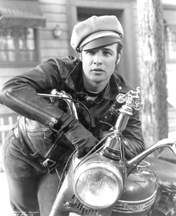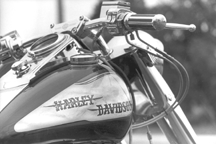Born to Be Mild
Nearly a half century after the havoc in Hollister, Harley-Davidsons have passed from the clutches of outlaw motorcycle cults to become the weekend playthings of RUBies--rich urban bikers
By Randy Fishel
FROM THE FOUR CORNERS of the North American continent, from Europe, Australia, South America and even Asia, in a thundering herd of speeding motorcycles, will come the new riders of the apocalypse. Drenched in black leather with new bandannas tied loosely around their necks, they'll grip tightly to the reins of their iron horses with skull-ringed fingers as they race to a date with destiny at the seat of creation, the place of primordial ooze: Hollister, California.
It is conceivable that more than 350,000 motorcyclists could show up in this small town of 19,000 residents on July 4, 1997. They will be there to celebrate the 50th anniversary of a minor disturbance that has grown to mythic proportions. Called a "motorcycle riot" by the local papers in 1947, the event was later glamorized in Stanley Kramer's 1953 classic film, The Wild One, starring Marlon Brando. Bound up for decades between legend and reality, it is still considered the seminal moment in the development of the "motorcycle outlaw" genre.
Hollister, it seems, was born wild. The town was named after pioneer and cattle rancher Joseph Hubbard Hollister, who was responsible for the first thundering herd to arrive there, driven across the plains to California in 1853. Many years later, after the impact of internal-combustion engines and those strange motorized bicycles that became the new "iron horses," the pastoral setting of small-town Hollister became the ideal location for a stop on the "Gypsy Tour."
The Gypsy Tour was a series of motorcycle competitions sponsored by the American Motorcycle Association. Scheduled during the spring and summer months, spectators and competitors would travel locally, regionally and sometimes across the country to participate. It was a venue for socializing as well as racing.
Harley-Davidson moves from outlaw
War of the Worlds
LIKE MANY OTHER pastimes and lifestyles however, it would be put on hold with the outbreak of the second world war. GIs returning from World War II were considerably different from their counterparts of previous wars. For one thing, there was little doubt about what they had been fighting for this time--the American way of life. Many would marry and settle down, buy a house, raise children and work a steady job.
They would live in and help construct an era when, as L.A. artist Robert Williams once put it, "mediocrity and conformity were next to Godliness."
But many would drift away from the pack. Among the brave and valiant survivors forever changed by the war experience, there was a significant number of ex-GIs who refused to go back to their pre-war existence. They wanted more action. One of the ways to find it was on a big motorcycle with a lot of "drag"--acceleration--and a "growler," a loud, un-muffled exhaust, or "straight-pipe."
Feeling expatriated within their own country, these rebellious riders headed out on the highway, looking for adventure. The motorcycles they chose were mainly American, mostly Harley-Davidson, and the rules of the "sport" they participated in were the ones made up as they went along.
It was such a group of loosely organized, nonaligned motorcyclists that rode into a Harley-Davidson/AMA sponsored "lifestyle" event in Hollister in 1947 on the Fourth of July.
Riders in the Sly: A fun-loving couple are ready to continue their journey from Santa Cruz to San Jose as part of a recent Hell's Angels Poker Run.
Media Turns the Wheels of Mythology
JUST ONE SENSATIONALIZED account of what happened appeared in the San Francisco Chronicle, which covered the event in its pages for seven days. Reports of "as many as 12,000 persons" in attendance on the first day transmogrified to an "estimated 4,000 motorcyclists." Despite the inaccuracy, there was something strangely visionary about the Chronicle's editorial that cautioned, "It was a performance which clearly proved that the straight-pipe motorcyclist, individually, has been underestimated as a social anarchist."
Here was the germ of identity, the seed of inspiration, that would grow in the fertile American cultural landscape, nourished by the news and entertainment industry. The media chain-reaction that began with the Bay Area press soon went national. Papers across the country covered the story. Life ran a pictorial documentary with a meager 115 words based on reports from the wire services. In 1949, writer Frank Rooney produced a short narrative called "Cyclist Raid" based on his reading of the Life article. Rooney's narrative was picked up by Harper's and serialized in 1951.
Stanley Kramer read the Harper's serial and came up with the idea for a movie. John Paxton, author of the original screenplay of The Wild One, based his script on Kramer's reading of Harper's. This now classic film developed a theme for a generation to both identify and internalize: the outlaw biker--a myth that would become reality.
The big American motorcycle soon became a vehicle of antisocial mobility. Much to the chagrin of both the Harley-Davidson Motor Company and the American Motorcycle Association, the genre emerged around the late '60s and '70s as an identifiable, circumscribed lifestyle. More than a brand name, Harley-Davidson had become a way of life.
Such a Gas: Found on everything from tacky candleholders to the ubiquitous black T-shirt, the Harley-Davidson logo rings cash registers to the tune of almost $300 million a year.
Image and Manipulation
ANY RIDERS WHO might appear in Hollister these days, however, may be vastly different from their early postwar ancestors, those original "straight-pipers." Still, law enforcement, local business and government officials are working hand-in-hand to try to stop an event that is currently in the planning stages. Many uninvited riders are excepted to attend this Thursday for a much-talked-about warm-up, the 49th anniversary celebration. But just who is in this new motorcycle brigade?
Armchair philosophers have all told us about the de-evolution of the biker outlaw genre from pastime to lifestyle to style. Indeed, for some new riders it has now become a ready-made, weekend identity. Expensive black-leather jackets hang in closets alongside Giorgio Armani suits, and RUBies--rich urban bikers--own $20,000 motorcycles that share garages with high-priced BMW and Mercedes-Benz automobiles. They've become The Wild One for brunch bunch.
But to be fair, there are still some old riders around that were in Hollister in 1947. Some of the founders of the Hell's Angels motorcycle club, members of a bomber support squadron during World War II, were there along with early clubs like the Tulare Rebels and the Boozefighters. Recognizing the historical significance of the original event, the Angels have had an annual Fourth of July run to Hollister since the early '50s.
Then there are the neotraditionalists, those young motorcycle enthusiasts who won't ride any Harley made after 1965. They will be there, too. So will the wide range of riders who participate because they are victims of style, myth consumers, advocates or adventurer wannabes. And you also can expect to see scores of new women riders who are now part of the genre.
At this stage, arguments about authenticity are difficult if not impossible. After all, it's the '90s and riding a bike is as authentic today as it ever was, just as long as the name on the motorcycle says Harley-Davidson. And if it does, there will probably be a whole lot of them in Hollister come this July. You just can't argue with tradition.
This page was designed and created by the Boulevards team.

Road Hog: In one of the earliest examples of product placement, Triumph garners a spot under Brando's still-slim butt for "The Wild Ones," although most outlaws laid claim to Harley-Davidson.

to gold-card status.

Robert Scheer
Robert Scheer
On Thursday (11am), a slew of motorcyclists from all over California will participate in "Johnny Returns: The Legend Ride #1," a commemorative ride from Seaside to Hollister that recalls the weekend immortalized in The Wild One. The event benefits the Polly Klaas Foundation and the Police Youth Activity Fund of Hollister. Those interested should gather at Bill's Monterey Custom Motorcycles, 2033 Del Monte Blvd., Seaside (899-1416).
From the July 3-10, 1996 issue of Metro Santa Cruz
Copyright © 1996 Metro Publishing and Virtual Valley, Inc.
